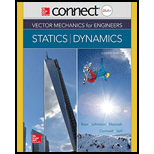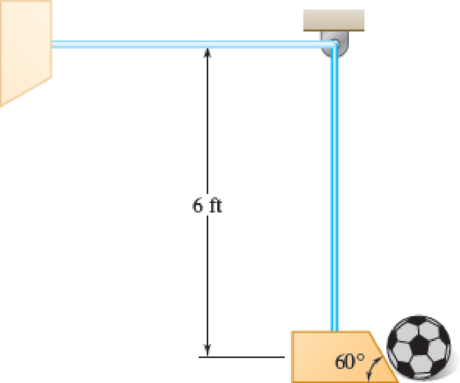
Concept explainers
A test machine that kicks soccer balls has a 5-lb simulated foot attached to the end of a 6-ft long pendulum arm of negligible mass. Knowing that the arm is released from the horizontal position and that the coefficient of restitution between the foot and the 1-lb ball is 0.8, determine the exit velocity of the ball (a) if the ball is stationary, (b) if the ball is struck when it is rolling toward the foot with a velocity of 10 ft/s.
Fig. P13.184

(a)
Find the exit velocity of the ball
Answer to Problem 13.184P
The exit velocity of the ball
Explanation of Solution
Given information:
The weight of the stimulated foot
The weight of the ball
The length of the pendulum arm (l) is
The coefficient of restitution between the foot (e) is 0.8.
The angle
The acceleration of gravity (g) is
Calculation:
Calculate the mass of the stimulated foot
Substitute
Calculate the mass of the ball
Substitute
Calculate the speed of the foot
Here,
Substitute 0 for
Substitute
Show the impulse momentum diagram for the ball and foot as Figure (1).

The expression for the velocity of the ball
The expression for the conservation of momentum of the ball in tangent t direction as follows:
Substitute
Substitute
The expression for the speed of the ball
The expression for the conservation of momentum of the system in x direction as follows:
Substitute
The expression for the velocity of foot
The expression for the velocity of foot
The expression for the velocity of ball
The expression for the coefficient of restitution for both ball and foot in normal direction as follows:
Substitute
Substitute
Solve the equations (2) and (3).
Calculate the magnitude of the exit velocity of the ball
Substitute
The velocity of the ball
Substitute 0 for
Calculate the direction of the velocity of the ball
Substitute
Substitute 0 for
Therefore, the exit velocity of the ball
(b)
Find the exit velocity of the ball
Answer to Problem 13.184P
The exit velocity of the ball
Explanation of Solution
Given information:
The weight of the stimulated foot
The weight of the ball
The length of the pendulum arm (l) is
The coefficient of restitution between the foot (e) is 0.8.
The angle
The velocity
Calculation:
Calculate the magnitude of the exit velocity of the ball
Substitute
Substitute
Calculate the direction of the velocity of the ball
Substitute
Substitute 0 for
Therefore, the exit velocity of the ball
Want to see more full solutions like this?
Chapter 13 Solutions
Connect 2 Semester Access Card for Vector Mechanics for Engineers: Statics and Dynamics
- Determine the altitude reached by the spacecraft of Prob. 14.95 when all the fuel of its launching rocket has been consumed.Reference to Problem 14.95:A 540-kg spacecraft is mounted on top of a rocket with a mass of 19 Mg, including 17.8 Mg of fuel. Knowing that the fuel is consumed at a rate of 225 kg/s and ejected with a relative velocity of 3600 m/s, determine the maximum speed imparted to the spacecraft if the rocket is fired vertically from the ground.arrow_forward(a). Two identical blocks A and B are at rest on a frictionless plane. Block C of the same weight hits block B with a velocity of 2.5 m/s. Knowing that the coefficient of restitution is 0.7 between block B and block C and 0.4 between block A and block B. (i) Determine the velocity of each block after all collisions have taken place. (ii) From your working in Q1(a)(i), predict whether there will be another collision after block B collides with block A? (iii) If the coefficient of restitution between block A and block B is changed to 0.7, explain with calculations whether there will be a collision between block B and block C after block B collides with block A?arrow_forwardA 600-g ball A is moving with a velocity of 6 m/s when it is hit as shown by a 1-kg ball B which has a velocity of magnitude 4 m/s. Knowing that the coefficient of restitution is 0.8 and assuming no friction, determine a) the velocity of each ball after impact b) energy lost during the impactarrow_forward
- A 0.25-lb ball thrown with a horizontal velocity v0 strikes a 1.5-lb plate attached to a vertical wall at a height of 36 in. above the ground. It is observed that after rebounding, the ball hits the ground at a distance of 24 in. from the wall when the plate is rigidly attached to the wall (Fig. 1) and at a distance of 10 in. when a foam-rubber mat is placed between the plate and the wall (Fig. 2). Determine (a) the coefficient of restitution e between the ball and the plate, (b) the initial velocity v0 of the ball.arrow_forwardDisks A and B have a mass of 6kg and 4kg, respectively. They are sliding on the smooth horizontal plane with the velocities shown. The coefficient of restitution is 0.6. a. Determine the angle between the velocity of B before collision and the line of impact. b. Determine the angle between the velocity of A before collision and the line of impact. c. Determine the angle between the velocity of B and the line of impact after collision. d. Determine the angle between the velocity of A and the line of impact after collision.arrow_forwardTwo disks sliding on a frictionless horizontal plane with opposite velocities of the same magnitude v0 hit each other squarely. Disk A is known to have a weight of 6 lb and is observed to have zero velocity after impact. Determine (a) the weight of disk B,knowing that the coefficient of restitution between the two disks is 0.5, (b) the range of possible values of the weight of disk B if the coefficient of restitution between the two disks is unknown.arrow_forward
- A 1-kg block B is moving with a velocity v0 of magnitude v0 = 2 m/s as it hits the 0.5-kg sphere A , which is at rest and hanging from a cord attached at 0 . Knowing that μk= 0.6 between the block and the horizontal surface and e = 0.8 between the block and the sphere, determine after impact (a) the maximum height h reached by the sphere, (b) the distance x traveled by the block.arrow_forwardTwo identical billiard balls can move freely on a horizontal table. Ball A has a velocity v0 as shown and hits ball B, which is at rest, at a point C defined by 0¸ = 45°. Knowing that the coefficient of restitution between the two balls is e = 0.8 and assuming no friction, determine the velocity of each ball after impact.arrow_forwardTwo spheres, each of mass m, can slide freely on a frictionless, horizontal surface. Sphere A is moving at a speed v0 = 16 ft/s when it strikes sphere B which is at rest, and the impact causes sphere B to break into two pieces, each of mass m/2.a) Knowing that 0.7 s after the collision one piece reaches Point C and 1.17 s after the collision the other piece reaches Point D, determine the velocity of sphere A after the collision.b) Knowing that 0.7 s after the collision one piece reaches Point C and 1.17 s after the collision the other piece reaches Point D, determine the angle θ and the speeds of the two pieces after the collision.arrow_forward
- NEED WITHIN 1HR THANKS 4.A 1.3-lb sphere A is dropped from a height of 1.8 ft onto 2.6-lb plate B, which is supported by a nested set of springs and is initially at rest. Knowing that the set of springs is equivalent to a single spring of constant k = 5 lb/in., determine the value of the coefficient of restitution between the sphere and the plate for which the height h reached by the sphere after rebound is maximum, the corresponding value of h, and the corresponding value of the maximum deflection of the plate.arrow_forwardA boy located at point A halfway between the center O of a semicircular wall and the wall itself throws a ball at the wall in a direction forming an angle of 45° with OA . Knowing that after hitting the wall the ball rebounds in a direction parallel to OA , determine the coefficient of restitution between the ball and the wall.arrow_forwardConservation of Linear Momentum for a System of Particles Two spheres A and B (of mass m each) were fired vertically from the ground with different initial velocities at different times. When sphere A reached its summit, sphere B, with an upward velocity of 17 m/s, created a head on collision with A. The impact caused sphere A to break into two pieces, each of mass m/2. Knowing one piece reached Point C and the other piece reached point D after the collision, determine (a) the velocity of sphere B after the collision; (b) the angle and the speeds of the two pieces after the collision; and (c) the force exerted by sphere A on B if the collision occurred in 0.001 s.arrow_forward
 Elements Of ElectromagneticsMechanical EngineeringISBN:9780190698614Author:Sadiku, Matthew N. O.Publisher:Oxford University Press
Elements Of ElectromagneticsMechanical EngineeringISBN:9780190698614Author:Sadiku, Matthew N. O.Publisher:Oxford University Press Mechanics of Materials (10th Edition)Mechanical EngineeringISBN:9780134319650Author:Russell C. HibbelerPublisher:PEARSON
Mechanics of Materials (10th Edition)Mechanical EngineeringISBN:9780134319650Author:Russell C. HibbelerPublisher:PEARSON Thermodynamics: An Engineering ApproachMechanical EngineeringISBN:9781259822674Author:Yunus A. Cengel Dr., Michael A. BolesPublisher:McGraw-Hill Education
Thermodynamics: An Engineering ApproachMechanical EngineeringISBN:9781259822674Author:Yunus A. Cengel Dr., Michael A. BolesPublisher:McGraw-Hill Education Control Systems EngineeringMechanical EngineeringISBN:9781118170519Author:Norman S. NisePublisher:WILEY
Control Systems EngineeringMechanical EngineeringISBN:9781118170519Author:Norman S. NisePublisher:WILEY Mechanics of Materials (MindTap Course List)Mechanical EngineeringISBN:9781337093347Author:Barry J. Goodno, James M. GerePublisher:Cengage Learning
Mechanics of Materials (MindTap Course List)Mechanical EngineeringISBN:9781337093347Author:Barry J. Goodno, James M. GerePublisher:Cengage Learning Engineering Mechanics: StaticsMechanical EngineeringISBN:9781118807330Author:James L. Meriam, L. G. Kraige, J. N. BoltonPublisher:WILEY
Engineering Mechanics: StaticsMechanical EngineeringISBN:9781118807330Author:James L. Meriam, L. G. Kraige, J. N. BoltonPublisher:WILEY





